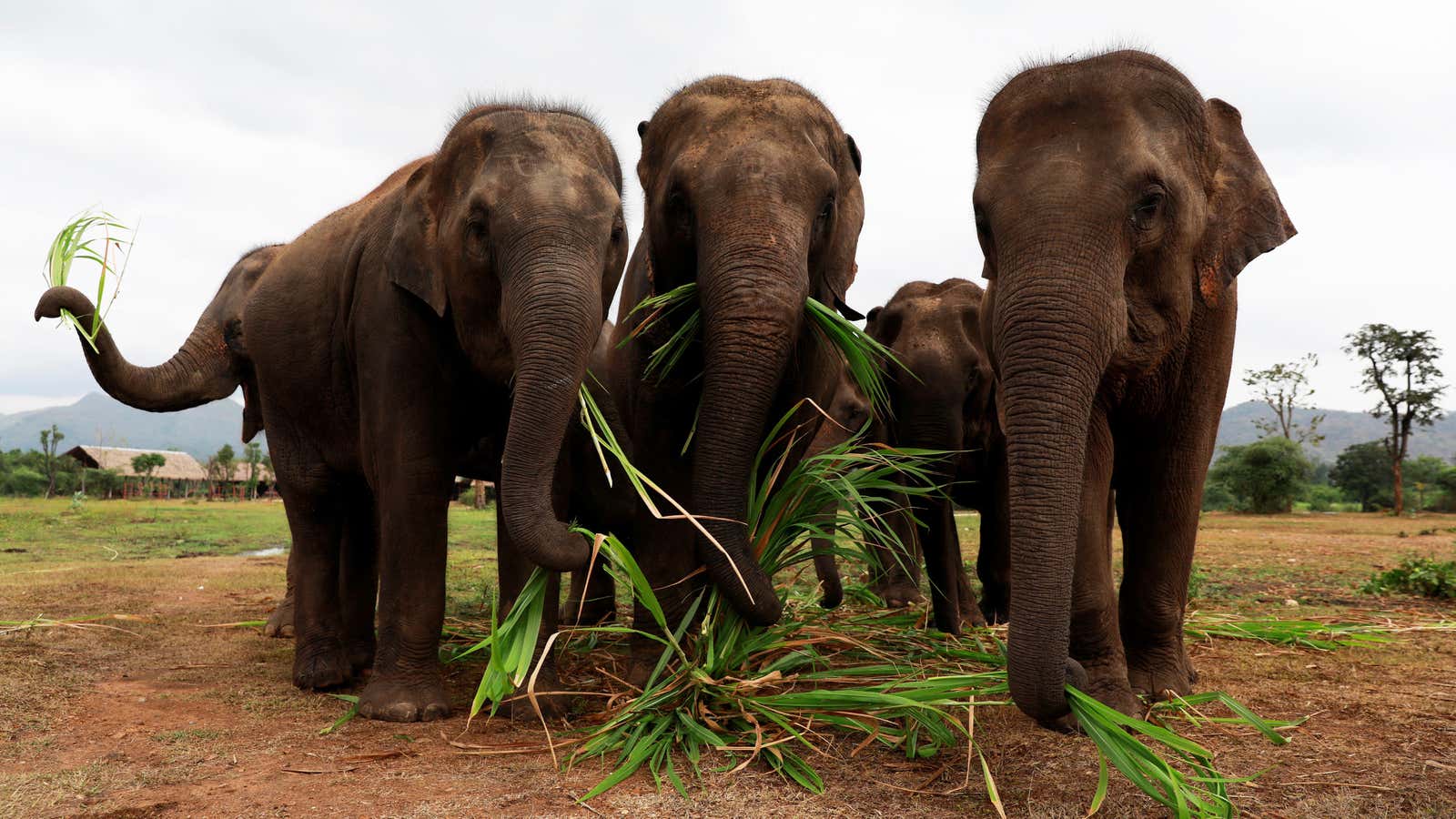Climate change is increasing the frequency of extreme weather events, which means we need to figure out how to deal with severe tsunamis and storms when they become the norm. How can human lives be saved in places where the roads are washed out and driving is impossible? Is there some kind of technology that might help?
Geographer Jacob Shell has an idea that involves employing an old and wise friend of humanity. In his upcoming book Giants of the Monsoon Forest—an ode to elephant intelligence and a history of their working relations with people in Asia—Shell suggests that training these smart creatures to be rescue workers would not only save human lives, but also ensure that the threatened animal survives.
Asian elephants are the world’s second largest land species, surpassed in size only by their own kind in Africa. Although both continents are home to these giant creatures, the animals’ fate differs drastically from one place to another.
African elephants face existential threats, like human hunting, but there are about 500,000 of them and they live in the wild. Asian elephants, on the other hand, are far fewer in number. There are only about 40,000 to 50,000 remaining. Of those, at least a quarter work alongside humans, laboring in the logging and transportation industries in the tropics of South Asia and Southeast Asia. They are part of a long line of domesticated working elephants that have for thousands of years lived and labored with humans.
Shell’s book examines the history of elephant domestication in Asia as the author travels to the forests of what is today Myanmar. It describes the rescue missions performed by the pachyderms during storms and at wartime, and their daily lives.
These working animals have an unusual relationship with people. They work by day and are free to roam the forests at night, eating what they please and mating with wild herds. In the mornings, the elephants’ caretakers—known as “mahouts” in English, a word derived from Hindi—go out in the forest to collect the creatures.
Usually the elephants are nearby, within a radius of one or two miles, and they join the mahouts voluntarily for a daily bath and brush before heading out to work. On the job, the pachyderms perform complex cognitive tasks when assisting with logging for the teak industry or transportation. They solve problems with no prompting, finding solutions that elude the humans, like figuring out how to clear a river logjam with a powerful foot or curling a massive tree safely in their trunk.
Unlike zoo creatures that are always confined to a closed space, the working elephants that Shell is describing are partly free. At night mahouts don’t chain the animals, which need more food than humans could collect to keep them sated. Instead, the people and beasts rely on a more symbiotic relationship. “I argue that Asian elephants have in effect formed a kind of interspecies alliance with humans,” Shell writes.
He contends that the elephants see cooperation with humans as key to their own survival. “And over hundreds of generations,” Shell explains, “Asian elephants have in effect cultivated skills that make them useful to…humans.”
People need the elephants to reach the places that roads do not go, places where the topography and weather conditions make permanent access difficult or impossible. Elephants are also good for surreptitious travel. Although they are giants, they wander quietly under the thick cover of forests along paths that are not easily tracked by those confined to vehicles, which makes them useful to humans.
Now, however, as markets are changing—teak logging is not as lucrative as it once was—and the land where elephants can roam free is dwindling, their long relationship with humans could come to an end. While Shell emphasizes the fact that the elephant-human bond should not be romanticized and acknowledges that for many animal lovers the notion of even semi-captive creatures is anathema, he believes that the survival of Asian elephants depends in great part on how much people feel they need them.
Shell sees an opportunity to renew the cross-species relationship in the face of climate change. Asian elephants have helped save human lives in the forests of Myanmar before—when refugees were fleeing then-Burma during World War II, for example, only elephants were capable of crossing the rising rivers and navigating the rain-soaked terrain to bring people to safety.
More recently, elephants helped with rescue efforts in 2004 and 2005 in Banda Aceh, on the Indonesian island of Sumatra, which was hit by a devastating tsunami. Mahouts and eight elephants were employed to haul away debris and help survivors reach their wrecked homes. For weeks, wheeled relief vehicles couldn’t reach many areas and the pachyderms were in high demand. Shell sees this as evidence that there is still much use for elephants, and argues that they could be trained for rescue purposes on a much larger scale.
There are obstacles to his plan. For one thing, not all the cities that might need an assist from elephants in times of emergency are designed to flood “clean,” meaning that the animals would have to work in dangerous conditions.
However imperfect this solution, Shell says it’s worth considering. “The prospects for the Asian elephant are bleak,” he concludes. He believes that if mahouts were enlisted in conservation efforts and could teach people what they know about the animals’ intelligence, sophistication, skills, and environment, the giants would have a better chance of survival.
Purists might not like Shells’ proposition that elephants be enlisted in a new line of work, and he is aware of potential criticism. Still, he writes, “What I would urge outsiders concerned for Asian elephants to consider is that the desire (an all-too-human desire) to gravitate toward the ‘pure’ or ‘perfect’ positions is not the same thing as Asian elephants’ desire to survive in a human-dominated world. The elephants do not have the luxury to ignore Voltaire’s old aphorism that the perfect is the enemy of the good.”
